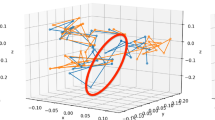Abstract
We present a new global optimization approach for solving exactly or inexactly constrained distance geometry problems. Distance geometry problems are concerned with determining spatial structures from measurements of internal distances. They arise in the structural interpretation of nuclear magnetic resonance data and in the prediction of protein structure. These problems can be naturally formulated as global optimization problems which generally are large and difficult. The global optimization method that we present is related to our previous stochastic/perturbation global optimization methods for finding minimum energy configurations, but has several key differences that are important to its success. Our computational results show that the method readily solves a set of artificial problems introduced by Moré and Wu that have up to 343 atoms. On a set of considerably more difficult protein fragment problems introduced by Hendrickson, the method solves all the problems with up to 377 atoms exactly, and finds nearly exact solution for all the remaining problems which have up to 777 atoms. These preliminary results indicate that this approach has very good promise for helping to solve distance geometry problems.
Similar content being viewed by others
References
A.T. Brünger and M. Nilgers, Computational Challenges for macromolecular structure determination by X-ray crystallography and solution NMR-spectroscopy, Q. Rev. Biophys., 26(1993), pp. 49–125.
R. H. Byrd, T. Derby, E. Eskow, K. Oldenkamp and R. B. Schnabel, A New Stochastic/Perturbation Method for Large-Scale Global Optimization and its Application to Water Cluster Problems, in Large-Scale Optimization: State of the Art, W. Hager, D. Hearn, and P. Pardalos, eds., Kluwer Academic Publishers, Dordrecht, The Netherlands, 1994, pp. 71–84.
R. H. Byrd, E. Eskow, A. van der Hoek, R. B. Schnabel, K. P. B. Oldenkamp, A Parallel Global Optimization Method for Solving Molecular Cluster and Polymer Conformation Problems, Proceedings of the Seventh SIAM Conference on Parallel Processing for Scientific Computing, D. H. Bailey, P. E. Bjørstad, J. R. Gilbert, M. V. Mascagni, R. S. Shreiber, H. D. Simon, V. J. Torczon, L. T. Watson, eds., SIAM, Philadelphia, 1995, pp. 72–77.
R. H. Byrd, E. Eskow and R. B. Schnabel, A New Large-Scale Global Optimization Method and its Application to Lennard-Jones Problems, University of Colorado Technical Report CU-CS-630-92.
R. H. Byrd, E. Eskow, A. van der Hoek, R. B. Schnabel, C.S. Shao, Z. Zou, Global Optimization Methods for Protein Folding Problems, DIMACS Vol. 23, Global Minimization of Nonconvex Energy Functions: Molecular Conformation and Protein Folding, DIMACS Workshop, Mar. 20–21, 1995, edited by P. Pardalos, D. Bhalloway, and G. Xue.
G.M. Crippen and T.F. Havel, Distance Geometry and Molecular Conformation, John Wiley & Sons, 1988.
W. Glunt, T.L. Hayden and M. Raydan, Molecular Conformation from Distance Matrices, J.Comp. Chem., 14(1993), pp. 114–120.
T.F. Havel, An Evaluation of Computational Strategies for Use in the Determination of Protein structure from Distance Geometry Constraints Obtained by Nuclear Magnetic Resonance, Prog. Biophys. Mol. Biol., 56(1991), pp. 43–78.
B.A. Hendrickson, The Molecule Problem: Exploiting Structure in Global Optimization, SIAM J. Optimization, Vol. 5(1995), No. 4, pp. 835–857.
I.D. Kuntz, J.F. Thomason and C.M. Oshiro, Distance Geometry, in Methods in Enzymology, N.J. Oppenheimer and T.L. James, eds., Vol. 177, Academic Press, 1993, pp. 159–204.
D.C. Liu and J. Nocedal, On the Limited Memory BFGS Method for Large Scale Optimization, Math. Prog., 45(1989), pp. 503–528.
Jorge J. Moré and Zhijun Wu, Global Continuation for Distance Geometry Problems, Preprint MCS-P505-0395, Argonne National Laboratory, Argonne, Illinois, 1995.
Jorge J. Moré and Zhijun Wu, ε-Optimial solutions to Distance Geometry Problems via Global Continuation, DIMACS Vol. 23, Global Minimization of Nonconvex Energy Functions: Molecular Conformation and Protein Folding, DIMACS Workshop, Mar. 20–21, 1995, edited by P. Pardalos, D. Shalloway, and G. Xue.
J.B. Saxe, Embeddability of Weighted Graphs in k-space is Strongly NP-hard, Proc. 17th Allerton Conference in Communications, Control and Computing, 1979, pp. 480–489.
C.-S. Shao, R.H. Byrd, E. Eskow and R.B. Schnabel, Global Optimization for Molecular Clusters Using a New Smoothing Approach, (1995).
Author information
Authors and Affiliations
Rights and permissions
About this article
Cite this article
Zou, Z., Bird, R.H. & Schnabel, R.B. A Stochastic/Perturbation Global Optimization Algorithm for Distance Geometry Problems. Journal of Global Optimization 11, 91–105 (1997). https://doi.org/10.1023/A:1008244930007
Issue Date:
DOI: https://doi.org/10.1023/A:1008244930007



